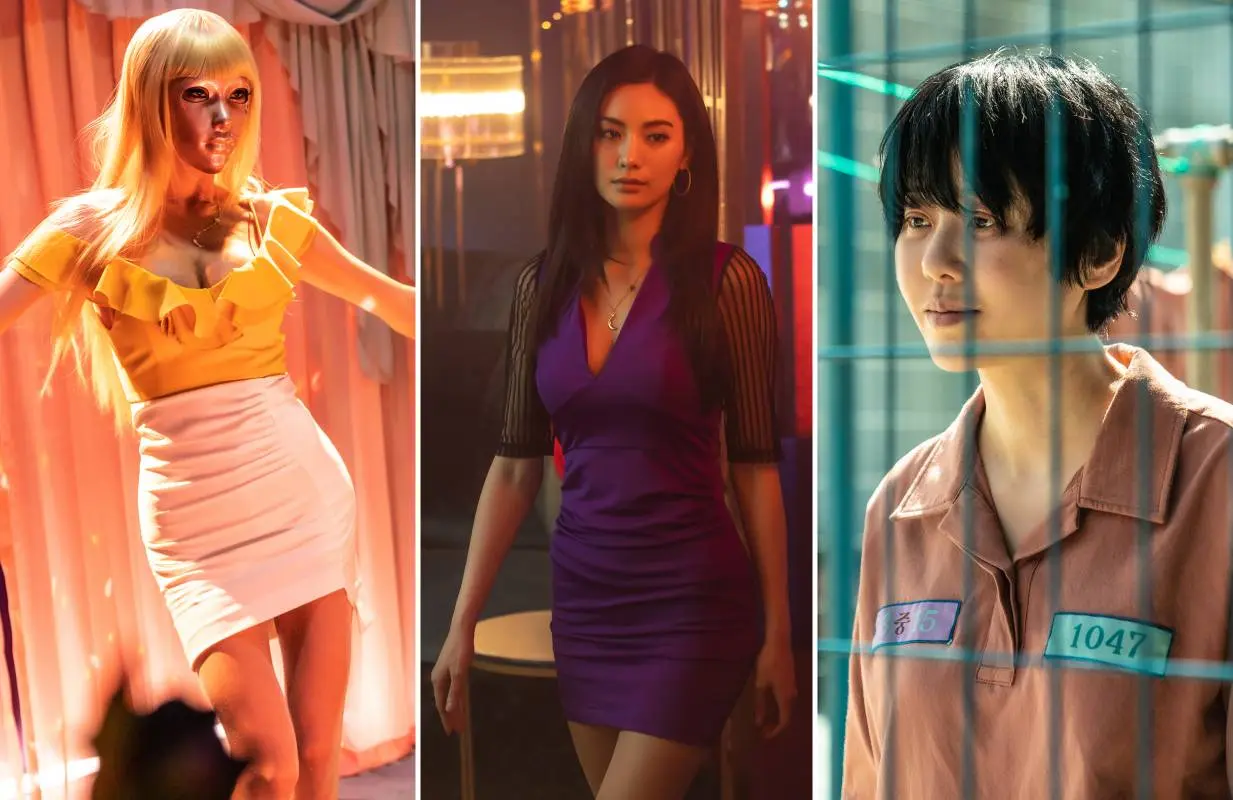
Lee Han-Byeol, Nana, and Go Hyun-Jung in Mask Girl (Photos: Jun Hea-sun/Netflix)
Kim Mo-mi, the central character in the Netflix K-drama Mask Girl, has always wanted to be a star. She learned early on how to dance and exude charm on stage, but was torn down by bullies who said that her face, which was not conventionally attractive, would stop her from becoming famous. But Mo-mi finds a way around that — she becomes Mask Girl online, guarding her visage and true name so that she can show off her skills and be whoever she wants to be. From that point on, the role is inhabited by three different actors, each signifying a distinct moment in Mo-mi’s life.
Mask Girl charts Mo-mi’s path from meek office worker with a secret to notorious serial killer. The murder spree starts by accident. As Mask Girl, Mo-mi has built up a rabid online following of men, offering her digital praise and money in exchange for her dance performances or seeing her drenched in milk. One man becomes overly obsessed with seeing her offline; after meeting up for drinks, he attempts to sexually assault her while berating her true appearance. Mo-mi fights him off and ends up killing him. This sets off a chain reaction of even more violent events and people desperate to know who is really behind Mask Girl.
Mo-mi’s life ends up split into three marked identities: the naive hopeless romantic (Lee Han-Byeol) from before the murder; the ultra-charming performer who is unafraid to defend her newfound confidence (Nana); and the weathered, wise prisoner who is searching for more meaning in life (Go Hyun-Jung). There is a narrative reasoning for each transition — Nana takes over after Mo-mi gets plastic surgery to make herself feel more attractive and Go steps in after some time has passed in prison. The choice to cast three different actors allows the production to avoid the pitfalls of poor make-up jobs distracting from the story. But it also allows each actor to bring something new to the character as she continues to alter how she wants to be perceived by the world.
Lee brings a more comedic and whimsical touch to the character, portraying someone who can (and will) easily escape into her own daydreams, sometimes to her detriment. Even in the darker scenes, she presents an innocence — that is, until she delivers the first blow to her attacker. Afterward, she stares at her face in the mirror as if she doesn’t recognize herself anymore. It’s the last we see of Lee in the series.
When Nana steps into the role, she has an air of confidence that feels somewhat familiar — the way she carries herself is reminiscent of Lee’s portrayal of the character when masked. Nana’s version of Mo-mi, though, doesn’t feel the need to hide her face anymore. That self-assuredness isn’t all it’s cracked up to be. While Lee’s Mo-mi is accompanied by her own voiceover telling her story, Nana takes over the role while other characters are describing their interactions with her. The mother of one of Mask Girl’s victims sees her as an evil temptress; her new best friend sees her as practically her twin because of their shared experiences; and the other prisoners see her as a threat because of her infamy. When it dawns on Mo-mi that the identity she so desperately sought might be her downfall, she once again takes a long hard look in the mirror, the last as Nana.
Go deftly wraps the mannerisms of her predecessors into her portrayal of the older and wiser Mo-mi. Her performance features a similar unassuming quality that Lee brought to the role, but this time it’s not because the character lacks self-confidence, it’s because she’s learned that it’s often easier to get what you want if you’re able to go unnoticed. In this chapter, Mo-mi is once again in charge of her own narrative, seeing herself for who she truly is, maybe for the first time.
As effective as it is to have three visibly different actors playing the same character as she works through different chapters of her life, it’s even more impressive that each actor is able to maintain enough similarities in their demeanors to make it clear they are portraying the same person. In particular, there’s a wry smile that creeps across each actor’s face in a nearly identical way when Mo-mi realizes that whatever plan she’s concocting, whether it be to woo her boss or escape prison, is about to work. And every time Mo-mi looks at herself in the mirror, no matter who is playing her, there’s a look of resignation in her eyes. No matter how hard she tries to manipulate her persona and outward appearance, she realizes, there’s no escaping the moments that have shaped her, and no mask (or recast) can hide that.
Mask Girl is streaming on Netflix.
Brianna Wellen is a TV Reporter at Primetimer who became obsessed with television when her parents let her stay up late to watch E.R.
ncG1vNJzZmivp6x7sb7IppytoZ2av2%2BvzqZmqq2ZmLiptdOsZqaZo6B6qLXRpWSnnaSbuarEjKWcnmWYlrturtiepqVlnpa7onnGqGShsaWjeqvBzaBkpKeimq6vecOrmKaZ